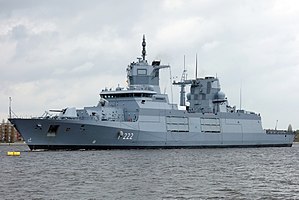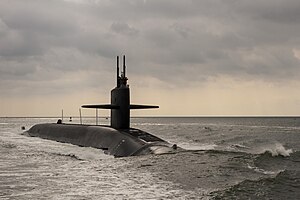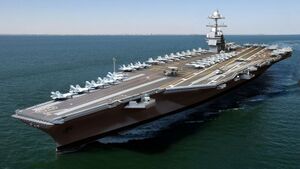Zamastanian Naval Forces: Difference between revisions
No edit summary |
No edit summary |
||
| Line 22: | Line 22: | ||
|org_type = Military, Navy | |org_type = Military, Navy | ||
|membership_type = | |membership_type = | ||
|membership = Total <br> - | |membership = Total <br> - 296,500 | ||
|admin_center_type = | |admin_center_type = | ||
|admin_center = | |admin_center = | ||
| Line 73: | Line 73: | ||
|footnotes = <!-- For generic non-numbered footnotes --> | |footnotes = <!-- For generic non-numbered footnotes --> | ||
}} | }} | ||
The '''Zamastanian Naval Forces''' (ZNF), is the naval warfare force of [[Zamastan]], operating under the overarching authority of the [[Zamastanian Armed Forces]]. It includes the '''Zamastanian Navy''' and the '''Marines'''. The Navy maintains a fleet of technologically sophisticated ships and submarines including seven aircraft carriers, | The '''Zamastanian Naval Forces''' (ZNF), is the naval warfare force of [[Zamastan]], operating under the overarching authority of the [[Zamastanian Armed Forces]]. It includes the '''Zamastanian Navy''' and the '''Marines'''. The Navy maintains a fleet of technologically sophisticated ships and submarines including seven aircraft carriers, amphibious transport docks, ballistic missile submarines, six nuclear fleet submarines, guided missile destroyers, frigates, corvettes, mine-countermeasure vessels and patrol vessels. It has 240 deployable combat vessels and more than 3,100 operational aircraft as of January 2020. The [[Zamastanian Air Force]] replenishes ZNF warships at sea, and augments the Navy's amphibious warfare capabilities through its three Bay-class landing ship vessels. It also works as a force multiplier for the Navy, often doing patrols that frigates used to do. The total displacement of the Navy is approximately 408,750 tonnes (706,759 tonnes including the Zamastan Fleet Auxiliary and Marines). | ||
== | ==Ships== | ||
===Aircraft carriers=== | ===Aircraft carriers=== | ||
[[File:Zms upham.jpg|thumb|right|The [[Talon-class nuclear aircraft carrier]] [[ZMS Upham]] off the coast of [[Providence]], [[Northern Isle]]]] | |||
An aircraft carrier is typically deployed along with a host of additional vessels, forming a carrier strike group. The supporting ships, which usually include three or four Aegis-equipped cruisers and destroyers, a frigate, and two attack submarines, are tasked with protecting the carrier from air, missile, sea, and undersea threats as well as providing additional strike capabilities themselves. Ready logistics support for the group is provided by a combined ammunition, oiler, and supply ship. | |||
The Navy has a statutory requirement for a minimum of 6 aircraft carriers. The navy is currently consistant of seven [[Talon-class nuclear aircraft carriers]], with the [[ZMS Castovia]] undergoing extensive systems and technologies testing until around 2021. | |||
*[[ZMS Upham]] | *[[ZMS Upham]] | ||
*[[ZMS Redeemer]] | *[[ZMS Redeemer]] | ||
| Line 88: | Line 88: | ||
*[[ZMS Albatross]] | *[[ZMS Albatross]] | ||
*[[ZMS Castovia]] | *[[ZMS Castovia]] | ||
=== | ===Amphibious warfare vessels=== | ||
Amphibious assault ships are the centerpieces of Zamastanian amphibious warfare and fulfill the same power projection role as aircraft carriers. However, their striking force centers on land forces instead of aircraft. They deliver, command, coordinate, and fully support all elements of a 2,000-men-strong Unit in an amphibious assault using both air and amphibious vehicles. | |||
===Cruisers=== | |||
[[File:ROKS_Sejong_the_Great_(DDG_991)_broadside_view.jpg|thumb|right|ZMS Clift, a [[Tregueux-class cruiser]]]] | |||
Cruisers are large surface combat vessels that conduct anti-air/anti-missile warfare, surface warfare, anti-submarine warfare, and strike operations independently or as members of a larger task force. Modern guided missile cruisers were developed out of a need to counter the anti-ship missile threat facing the Zamastanian Navy | |||
===Destroyers=== | |||
[[File:BADEN-WURTTEMBERG_00257_(cropped).jpg|thumb|right|ZMS Tobias, a [[Percilius-class destroyer|Percilius-class]] guided missile destroyer]] | |||
Destroyers are multi-mission medium surface ships capable of sustained performance in anti-air, anti-submarine, anti-ship, and offensive strike operations. Like cruisers, guided missile destroyers are primarily focused on surface strikes using the [[Firebird Land Attack Missile]]s and fleet defense through missile systems. | |||
===Frigates and Littoral combat ships=== | |||
[[File:Singapore_Navy_guided-missile_frigate_RSS_Steadfast.jpg|thumb|right|ZMS Harodia, a [[Tavoka-class frigate]] operating during the [[Gladysynthia Crisis]]]] | |||
[[File:Zms avi taures.jpg|thumb|right|ZMS Avi Taures, a [[Osprey-class littoral combat ship]] named after the [[President of Zamastan|Zamastanian President]], [[Avi Taures]]]] | |||
Modern frigates and littoral combat ships mainly perform anti-submarine warfare for carrier and expeditionary strike groups and provide armed escort for supply convoys and merchant shipping. They are designed to protect friendly ships against hostile submarines in low to medium threat environments, using torpedoes and helicopters. Independently, frigates are able to conduct counterdrug missions and other maritime interception operations. As in the case of destroyers, frigates are named after Navy, Marine, and Coast Guard heroes, though the flagship of Zamastanian frigates and Littoral combat ships is named after [[President of Zamastan|President]] [[Avi Taures]]. | |||
===Mine countermeasures ships=== | |||
Mine countermeasures vessels are a combination of minehunters, a naval vessel that actively detects and destroys individual naval mines, and minesweepers, which clear mined areas as a whole, without prior detection of the mines. The navy has approximately a dozen of these in active service, but the mine countermeasure (MCM) role is also being assumed by the incoming classes of littoral combat ships. MCM vessels have mostly legacy names of previous Zamastanian Navy ships, especially [[World War (Iearth)|World War]]-era minesweepers. | |||
=== | |||
===Mine | |||
===Patrol vessels=== | ===Patrol vessels=== | ||
A patrol boat is a relatively small naval vessel generally designed for coastal defense duties. There have been many designs for patrol boats, though the navy currently only has a single class. They may be operated by a nation's navy or coast guard, and may be intended for marine ("blue water") or estuarine or river ("brown water") environments. The Navy's approximately 50 patrol ships are mainly used in home port patrols and drug interdiction missions. | |||
===Submarines=== | |||
[[File:Flickr_-_Official_U.S._Navy_Imagery_-_USS_Maryland_transits_the_Saint_Marys_River..jpg|thumb|right|ZMS Ruddigan, a [[Jade-class nuclear submarine]]]] | |||
All current and planned Zamastanian Navy submarines are nuclear-powered, as only nuclear propulsion allows for the combination of stealth and long duration, high-speed sustained underwater movement that makes modern nuclear submarines so vital to a modern blue-water navy. The U.S. Navy operates three types: ballistic missile submarines, guided missile submarines, and attack submarines. Navy (nuclear) ballistic missile submarines carry the stealthiest leg of the Zamastanian strategic triad (the other legs are the land-based Zamastanian strategic missile force and the air-based Zamastanian strategic bomber force). The primary missions of attack and guided missile submarines in the Navy are peacetime engagement, surveillance and intelligence, special operations, precision strikes, and control of the seas. | |||
==Operations== | ==Operations== | ||
Revision as of 01:54, 10 May 2020
Zamastanian Naval Forces Z.N.F. | |
|---|---|
| Type | Military, Navy |
| Membership | Total - 296,500 |
| Leaders | |
| Foley Sakzi | |
| Curtis Fondaden | |
| Establishment | September 3rd, 1805 |
The Zamastanian Naval Forces (ZNF), is the naval warfare force of Zamastan, operating under the overarching authority of the Zamastanian Armed Forces. It includes the Zamastanian Navy and the Marines. The Navy maintains a fleet of technologically sophisticated ships and submarines including seven aircraft carriers, amphibious transport docks, ballistic missile submarines, six nuclear fleet submarines, guided missile destroyers, frigates, corvettes, mine-countermeasure vessels and patrol vessels. It has 240 deployable combat vessels and more than 3,100 operational aircraft as of January 2020. The Zamastanian Air Force replenishes ZNF warships at sea, and augments the Navy's amphibious warfare capabilities through its three Bay-class landing ship vessels. It also works as a force multiplier for the Navy, often doing patrols that frigates used to do. The total displacement of the Navy is approximately 408,750 tonnes (706,759 tonnes including the Zamastan Fleet Auxiliary and Marines).
Ships
Aircraft carriers
An aircraft carrier is typically deployed along with a host of additional vessels, forming a carrier strike group. The supporting ships, which usually include three or four Aegis-equipped cruisers and destroyers, a frigate, and two attack submarines, are tasked with protecting the carrier from air, missile, sea, and undersea threats as well as providing additional strike capabilities themselves. Ready logistics support for the group is provided by a combined ammunition, oiler, and supply ship.
The Navy has a statutory requirement for a minimum of 6 aircraft carriers. The navy is currently consistant of seven Talon-class nuclear aircraft carriers, with the ZMS Castovia undergoing extensive systems and technologies testing until around 2021.
Amphibious warfare vessels
Amphibious assault ships are the centerpieces of Zamastanian amphibious warfare and fulfill the same power projection role as aircraft carriers. However, their striking force centers on land forces instead of aircraft. They deliver, command, coordinate, and fully support all elements of a 2,000-men-strong Unit in an amphibious assault using both air and amphibious vehicles.
Cruisers

Cruisers are large surface combat vessels that conduct anti-air/anti-missile warfare, surface warfare, anti-submarine warfare, and strike operations independently or as members of a larger task force. Modern guided missile cruisers were developed out of a need to counter the anti-ship missile threat facing the Zamastanian Navy
Destroyers

Destroyers are multi-mission medium surface ships capable of sustained performance in anti-air, anti-submarine, anti-ship, and offensive strike operations. Like cruisers, guided missile destroyers are primarily focused on surface strikes using the Firebird Land Attack Missiles and fleet defense through missile systems.
Frigates and Littoral combat ships

Modern frigates and littoral combat ships mainly perform anti-submarine warfare for carrier and expeditionary strike groups and provide armed escort for supply convoys and merchant shipping. They are designed to protect friendly ships against hostile submarines in low to medium threat environments, using torpedoes and helicopters. Independently, frigates are able to conduct counterdrug missions and other maritime interception operations. As in the case of destroyers, frigates are named after Navy, Marine, and Coast Guard heroes, though the flagship of Zamastanian frigates and Littoral combat ships is named after President Avi Taures.
Mine countermeasures ships
Mine countermeasures vessels are a combination of minehunters, a naval vessel that actively detects and destroys individual naval mines, and minesweepers, which clear mined areas as a whole, without prior detection of the mines. The navy has approximately a dozen of these in active service, but the mine countermeasure (MCM) role is also being assumed by the incoming classes of littoral combat ships. MCM vessels have mostly legacy names of previous Zamastanian Navy ships, especially World War-era minesweepers.
Patrol vessels
A patrol boat is a relatively small naval vessel generally designed for coastal defense duties. There have been many designs for patrol boats, though the navy currently only has a single class. They may be operated by a nation's navy or coast guard, and may be intended for marine ("blue water") or estuarine or river ("brown water") environments. The Navy's approximately 50 patrol ships are mainly used in home port patrols and drug interdiction missions.
Submarines

All current and planned Zamastanian Navy submarines are nuclear-powered, as only nuclear propulsion allows for the combination of stealth and long duration, high-speed sustained underwater movement that makes modern nuclear submarines so vital to a modern blue-water navy. The U.S. Navy operates three types: ballistic missile submarines, guided missile submarines, and attack submarines. Navy (nuclear) ballistic missile submarines carry the stealthiest leg of the Zamastanian strategic triad (the other legs are the land-based Zamastanian strategic missile force and the air-based Zamastanian strategic bomber force). The primary missions of attack and guided missile submarines in the Navy are peacetime engagement, surveillance and intelligence, special operations, precision strikes, and control of the seas.

